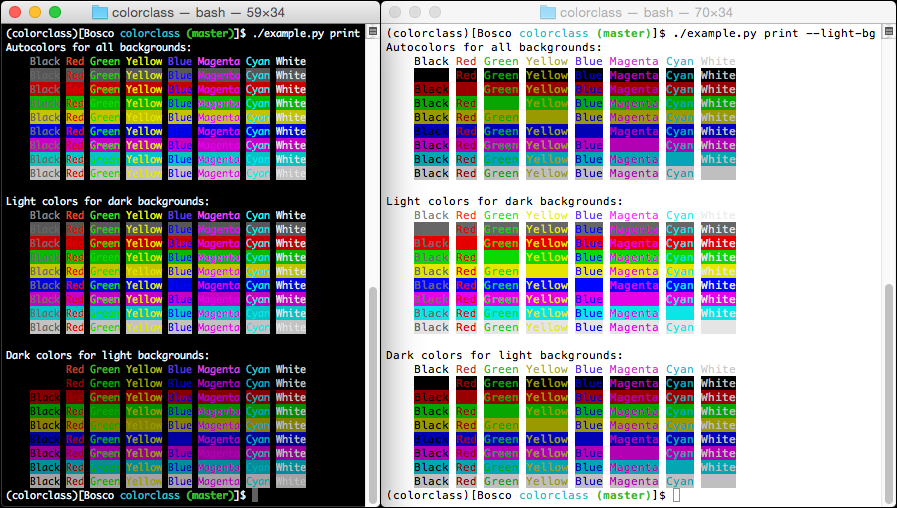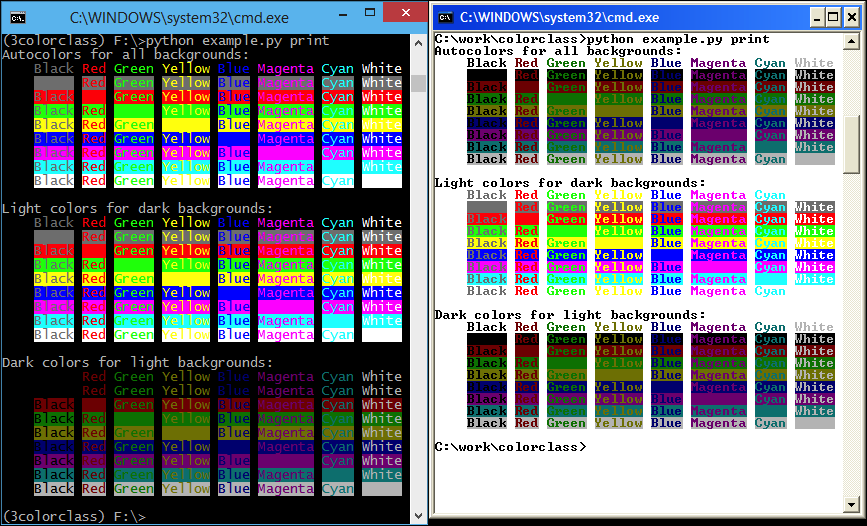Colorful worry-free console applications for Linux, Mac OS X, and Windows.
Project description
Yet another ANSI color text library for Python. Provides “auto colors” for dark/light terminals. Works on Linux, OS X, and Windows. For Windows support you just need to call Windows.enable() in your application.
On Linux/OS X autocolors are toggled by calling set_light_background() and set_dark_background(). On Windows this can be done automatically if you call Windows.enable(auto_colors=True). Even though the latest Windows 10 does support ANSI color codes natively, you still need to run Windows.enable() to take advantage of automatically detecting the console’s background color.
In Python2.x this library subclasses unicode, while on Python3.x it subclasses str.
Python 2.6, 2.7, PyPy, PyPy3, 3.3, 3.4, and 3.5 supported on Linux and OS X.
Python 2.6, 2.7, 3.3, 3.4, and 3.5 supported on Windows (both 32 and 64 bit versions of Python).





Quickstart
Install:
pip install colorclassPiped Command Line
It is possible to pipe curly-bracket tagged (or regular ANSI coded) text to Python in the command line to produce color text. Some examples:
echo "{red}Red{/red}" |python -m colorclass # Red colored text.
echo -e "\033[31mRed\033[0m" | COLOR_DISABLE=true python -m colorclass # Strip colors
echo -e "\033[31mRed\033[0m" | COLOR_ENABLE=true python -m colorclass &> file.txt # Force colors.Export these environment variables as “true” to enable/disable some features:
Env Variable |
Description |
|---|---|
COLOR_ENABLE |
Force colors even when piping to a file. |
COLOR_DISABLE |
Strip all colors from incoming text. |
COLOR_LIGHT |
Use light colored text for dark backgrounds. |
COLOR_DARK |
Use dark colored text for light backgrounds. |
Example Implementation


Source code for the example code is: example.py
Usage
Different colors are chosen using curly-bracket tags, such as {red}{/red}. For a list of available colors, call colorclass.list_tags().
The available “auto colors” tags are:
autoblack
autored
autogreen
autoyellow
autoblue
automagenta
autocyan
autowhite
autobgblack
autobgred
autobggreen
autobgyellow
autobgblue
autobgmagenta
autobgcyan
autobgwhite
Methods of Class instances try to return sane data, such as:
from colorclass import Color
color_string = Color('{red}Test{/red}')
color_string
u'\x1b[31mTest\x1b[39m'
len(color_string)
4
color_string.istitle()
TrueThere are also a couple of helper attributes for all Color instances:
color_string.value_colors
'\x1b[31mTest\x1b[39m'
color_string.value_no_colors
'Test'Changelog
This project adheres to Semantic Versioning.
2.1.1 - 2016-05-10
- Fixed
Printing box drawing characters on Windows from Python 2.6.
2.1.0 - 2016-05-07
- Added
keep_tags boolean keyword argument to Color(). Prevents colorclass from parsing curly brackets.
Automatically skip replacing stderr/stdout streams on latest Windows 10 versions with native ANSI color support.
- Changed
Refactored most of windows.py.
Background color determined from either stderr or stdout, instead of just one stream (e.g. piping stderr to file).
- Fixed
2.0.0 - 2016-04-10
- Added
Python 3.5 support.
enable_all_colors(), is_enabled(), and is_light() toggle functions.
Library can be used as a script (e.g. echo "{red}Red{/red}" |python -m colorclass).
Ability to add/multiply Color instances just like str.
Ability to iterate a Color instance and have each character keep its color codes.
- Changed
Converted library from Python module to a package.
set_light_background() and set_dark_background() no longer enable colors. Use enable_all_colors().
Colors are disabled by default when STDERR and STDOUT are not streams (piped to files/null). Similar to grep.
Reduce size of ANSI escape sequences by removing codes that have no effect. e.g. \033[31;35m to \033[35m.
Color methods that return strings now return Color instances instead of str instances.
- Fixed
1.2.0 - 2015-03-19
- Added
Convenience single-color methods by Marc Abramowitz.
1.1.2 - 2015-01-07
- Fixed
Maintaining Color type through .encode() and .decode() chains.
1.1.1 - 2014-11-03
- Fixed
Python 2.7 64-bit original colors bug on Windows.
resetting colors when reset_atexit is True.
Improved sorting of list_tags().
1.1.0 - 2014-11-01
- Added
Native Windows support and automatic background colors.
1.0.2 - 2014-10-20
- Added
Ability to disable/strip out all colors.
1.0.1 - 2014-09-11
- Fixed
splitlines() method.
1.0.0 - 2014-09-01
Initial release.
Project details
Release history Release notifications | RSS feed
Download files
Download the file for your platform. If you're not sure which to choose, learn more about installing packages.
Source Distribution
File details
Details for the file colorclass-2.1.1.tar.gz.
File metadata
- Download URL: colorclass-2.1.1.tar.gz
- Upload date:
- Size: 16.8 kB
- Tags: Source
- Uploaded using Trusted Publishing? No
File hashes
| Algorithm | Hash digest | |
|---|---|---|
| SHA256 | ac65283485645cc4c137eef37d5d46453925d965ff937a26343a36746925cc7e |
|
| MD5 | 2cda3cfd38230ebba3ce331cf8d71ee3 |
|
| BLAKE2b-256 | b9627c0ca545c593dd92ebbf89b20e69256639f0492a92cbc568223b2586a1a5 |











